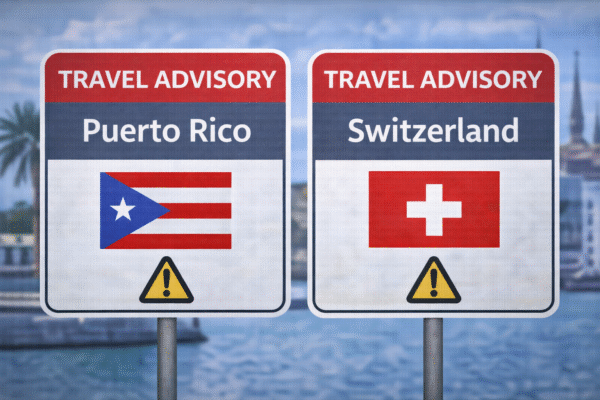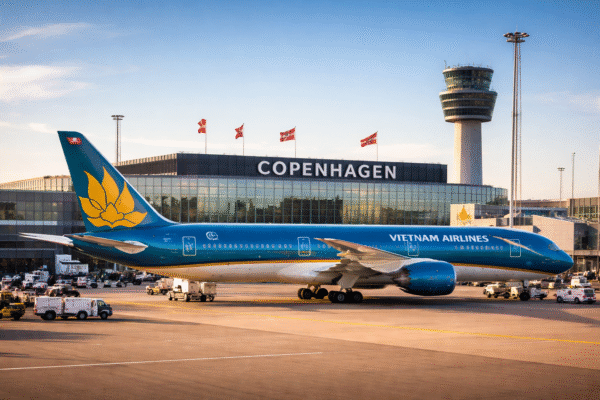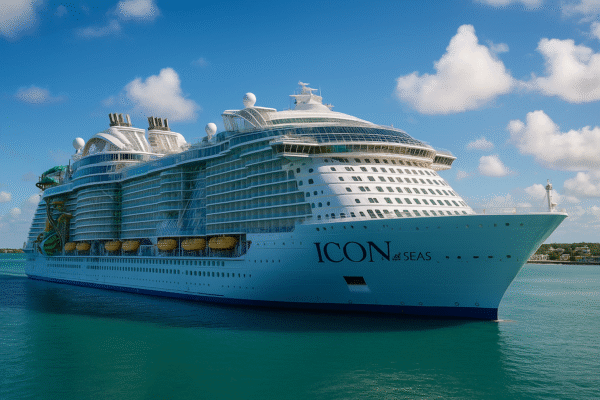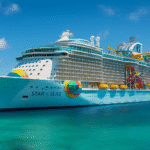In 2025, mega cruise ships are not just making waves—they’re rewriting the entire script of ocean travel. These engineering marvels are no longer just vessels for transportation; they’re fully immersive vacation destinations, blending cutting-edge technology, ultra-luxury accommodations, and a serious commitment to environmental sustainability. At the forefront of this cruise revolution are Royal Caribbean’s Icon of the Seas and the soon-to-launch Star of the Seas, both symbols of a new era in maritime tourism.
The Rise of Floating Cities at Sea
Mega cruise ships in 2025 resemble floating cities more than traditional vessels. At over 250,000 gross tons and with capacities exceeding 7,600 passengers, these ships offer an all-inclusive experience that rivals the amenities of land-based resorts. Icon of the Seas, the largest cruise ship in the world, launched from PortMiami in early 2024 and immediately set a new industry benchmark.
Key features of these vessels include:
- Neighborhood-style layouts with themed zones, such as family adventure parks, adult-only wellness retreats, and open-air entertainment arenas.
- Technologically integrated cabins with app-controlled lighting, entertainment, and personalized concierge services.
- Massive waterparks, skating rinks, and multi-deck theaters showcasing Broadway-caliber performances.
Royal Caribbean’s vision reflects a future where every traveler can find their niche, whether they’re thrill-seekers, luxury lovers, or eco-conscious cruisers.
Innovation Meets Sustainability at Sea
Perhaps the most significant shift in cruise design is the prioritization of eco-friendly operations. The Icon and Star of the Seas are both powered by liquefied natural gas (LNG)—a major improvement over traditional marine fuels. LNG reduces emissions of sulfur oxides, nitrogen oxides, and particulates, helping cruise operators comply with IMO 2020 regulations and port-specific environmental mandates, especially in sensitive regions like the Caribbean and Northern Europe.
Additional green innovations include:
- Shore power capability, enabling ships to plug in while docked to avoid burning fuel.
- Waste heat recovery systems that recycle energy to power air conditioning and other onboard systems.
- Advanced water treatment facilities that exceed international discharge standards.
According to the International Maritime Organization (IMO), the cruise sector’s shift toward LNG and hybrid technologies marks a crucial step toward carbon-neutral cruise tourism by 2050.
Economic Boost for Global Port Cities
The size and popularity of mega ships are prompting global ports to invest in upgraded infrastructure. In the United States, Port Canaveral, Florida—a major embarkation hub for Royal Caribbean—recently completed a $155 million cruise terminal expansion with LNG bunkering capabilities and enhanced passenger processing systems.
These developments are more than logistical upgrades—they’re economic engines:
- Increased cruise traffic translates to more hotel stays, dining, shopping, and tour bookings in homeport and port-of-call cities.
- According to the Cruise Lines International Association (CLIA), each port call from a mega ship can inject up to $1 million into a local economy.
- New jobs are being created in port operations, environmental management, and tourism services.
Across Europe and Asia, cities like Barcelona, Singapore, and Sydney are also investing in port modernization and green terminal design to remain competitive in the mega cruise age.
Luxury Redefined: Experiences Beyond the Horizon
Today’s mega ships are also elevating onboard luxury to a whole new level. Guests can book multi-story loft suites with private terraces, dine at Michelin-starred chef-led restaurants, and rejuvenate in spa sanctuaries inspired by global wellness traditions.
Onboard entertainment has also evolved:
- The AquaDome on Icon of the Seas combines panoramic sea views with water-based acrobatic shows.
- VR escape rooms and simulated skydiving zones offer next-gen adventure without ever leaving the ship.
- Family travelers benefit from dedicated zones like Surfside, where everything is child-centric—from splash pads to kid-approved cuisine.
Luxury is no longer defined by exclusivity, but by customization, immersion, and sustainability—a trifecta that’s proving highly attractive to next-gen travelers.
What’s Next for the Cruise Industry?
Royal Caribbean is already building the next ship in the Icon-class series, slated for delivery in 2026. Industry insiders anticipate even more:
- Artificial intelligence for real-time crowd management and energy optimization.
- Autonomous navigation technologies to reduce crew workload and improve fuel efficiency.
- Expanded itineraries to emerging destinations, including Antarctica, the South Pacific, and Northern Canada.
Governments are also getting involved. For example, Singapore Tourism Board (STB) and Royal Caribbean signed a Memorandum of Understanding in 2023 to jointly promote sustainable cruise growth in Southeast Asia, helping integrate cruise itineraries with eco-tourism and cultural heritage programs.
Conclusion: The Future Is on the Water
Mega cruise ships in 2025 are not only transforming how we vacation—they are reshaping the future of global tourism. These vessels represent the cruise industry’s most ambitious and comprehensive response to consumer demand for innovation, luxury, and sustainability.
As cruise lines continue to invest in cleaner fuel technologies, immersive entertainment, and tailored guest experiences, ocean travel is emerging as one of the most exciting, dynamic, and sustainable sectors of the tourism industry.
With floating cities now offering journeys that rival any land-based destination, it’s clear: the future of travel is not just about where you go, but how spectacularly you get there.
For more travel news like this, keep reading Global Travel Wire


















